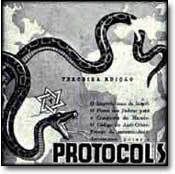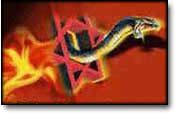The newly-vernal sun beat down hot last Friday afternoon in the
Palestinian West Bank village of Bi'lin. A group of around 70 protesters
squinted as they walked from heart of the village, arrived at its
fields and, finally, at the concrete wall that brings the road to an
abrupt end. By the time I arrived at the rear of the procession, three
or four shabaab—youths from the village—had already set a small
fire at the wall's base. They wound up slingshots over their masked
heads and tossed stones with little success at both audiences on the
other side: a group of onlooking Ultra-Orthodox men from the adjacent
Israeli settlement on Bil'in's lands, and two Israeli army trucks
perched atop another mound of dirt on the right.
Among the protesters, I ran into Ahmed Khatib, a Bil'in native whom I'd met the week before at the
now-demolished Palestinian "anti-settlement" protest village of
Bab al-Shams.
He put an arm around my shoulder and swept his free hand along the path
of the wall. "Non-violent," he exclaimed, reprising a theme
he'd harped on at Bab al-Shams. Nearby locals chuckled at his remark and Khatib reconsidered with a smile: "
Noos-violent,"
he said, mixing the Arabic word for "half" with his English. The army
met the stone-throwing with a fecal-smelling concoction called "skunk"
and later with tear gas. Eventually, soldiers crossed through a gate
into the fields and, about an hour and a half after the protest started,
a squad of troops stormed the dispersed demonstration from the north,
sending the bulk of the activists scurrying back along the road toward
the village.
By
car, the distance traveled between the center of Tel Aviv and Bil'in is
that of a marathon: 26 miles. But they are worlds apart, not least
because of the military checkpoint and concrete wall separating the two.
By the time a visitor crosses, they're already deep into the West Bank,
having passed by Modi'in Illit, the most populous of the many Israeli
settlements throughout the territory. This month, Bil'in celebrated the
eighth anniversary of unarmed—though not totally non-violent—protests
against the wall that was set to cut the village off from half of its
farmland. After a 2007 Israeli Supreme Court ruling that the wall must
be closer to the settlement itself, the sectioned concrete structure
finally went up along its new path, still swallowing up about a quarter
of the villagers' land. "Even if Israel were to agree to leave the West
Bank, Green Park"—the section of Modi'in Illit abutting the wall by
Bil'in—"would not be evacuated,"
wrote the Israeli journalist Noam Sheizaf, a friend and my travel companion on Friday. "Even Palestinian negotiators
agreed to have it annexed to Israel in exchange
for equal territory elsewhere. Thus, the Palestinian people might one
day be compensated for the land that was taken from Bil’in, but the
people of the village—its owners—will not." And so they continue to
protest, for their land and against the occupation in general; one aim
sure to be denied and the other often seeming just as unlikely.
The
Supreme Court victory—a rare success for anti-occupation
protesters—brought international fame to Bil'in, bolstered by this
year's Oscar nomination for the documentary Five Broken Cameras, where
years' worth of a local's video footage showed the village's struggle. A
disused dirt path just past the village's last homes is all that
remains of the fence that held the wall's place until the court ruling
was implemented in 2011. The proximity of the old route and the village
brought Israeli incursions and, more frequently, tear gas directly into
town every Friday. In the intervening years between the ruling and the
removal of the fence, two local protesters died. As documented in Five
Broken Cameras, protest organizer Bassem Abu Rameh was
killed in 2009 by
a teargas canister that struck him in the chest, and his sister Jawahar
died two years later from inhaling large quantities of the gas. (The
Israeli military sought to deflect responsibility for the latter death
by
spinning—and sometimes lying to—right-wing Israeli blogs.)
Now with the fence gone, heads of lettuce dot sections of the fields
past the wall's old path and a new playground popped up on the village's
side of the new wall.
On
Friday, a few clouds of teargas wafted over the swings and slides. The
breeze, favorable to the protesters, made it possible to dodge the gas
by hopping over the terraces' low, stone walls. But moving up the hill I
was still caught by some smoke, causing profuse coughing, eye watering,
and a runny nose. The well-organized locals distributed alcohol swabs
to wipe around one's eyes, and remained poised under its
effects. Finally, the army crossed and fired further up the hill,
chasing the demonstrations back toward the village. "It's the first time
I've seen them come this deep" into the fields since the fence was
removed, a villager who only gave his name as Mohammed told me. Others
addressed the army directly: "You received illegal orders," Ahmed Khatib
shouted at the soldiers in Hebrew. "Passing the wall is an offense.
This was your decision and you shouldn't have done it." The army
directed its response not to Khatib, but at one of the youths: "You,
with the white shirt. If you come any closer, we'll shoot you," a voice
announced in Druze-accented Arabic from the jeep's loudspeaker,
threatening to escalate the light clash by using rubber-coated steel
bullets. "Go home!" Despite the rock throwing, the order sounded strange
after the Israelis had crossed into the village's lands.
In the
end, the soldiers storming the upper fields succeeded in driving away
only the non-violent mass of protesters, roughly split
between Bil'in natives and internationals, including Israelis. The few shabaab lingered to exchange more stones for more teargas canisters. Both exist in seemingly unlimited quantities in the West Bank.
http://www.thedailybeast.com/articles/2013/04/02/after-victory-palestinian-village-runs-into-a-wall.html
![[9_10_s22.jpg]](https://blogger.googleusercontent.com/img/b/R29vZ2xl/AVvXsEjTXnQay9wzz0E6nVHrVhaHKoq_zYXDqZjijHlNDQzj90MZzInrCuVX4ciFYCiBfZ7lhlgr2bBhhnl7ddWbhdih5JbXjQYbA605TNyiq046bQqjG2A4S-nHTmh1VBTQSG6tmc23wq47QQ/s1600/9_10_s22.jpg)




No comments:
Post a Comment